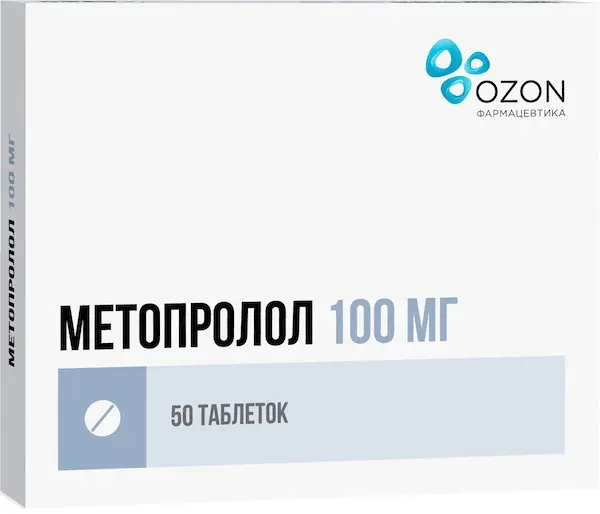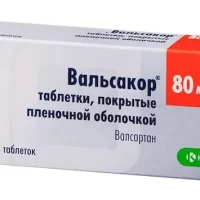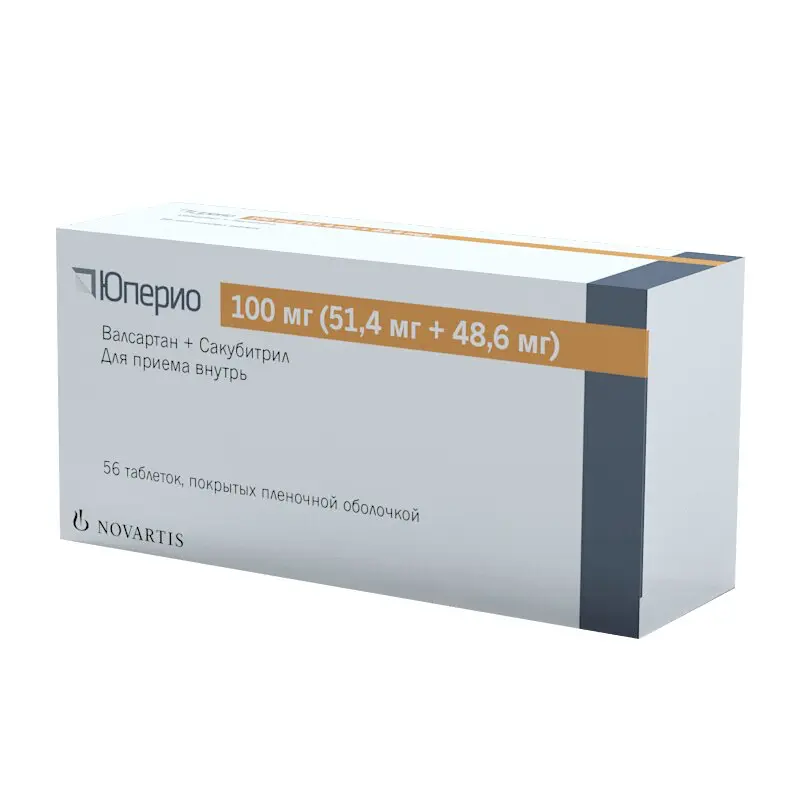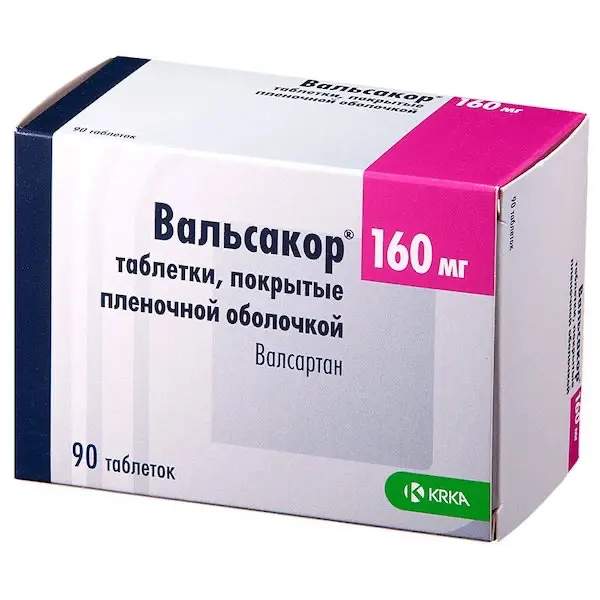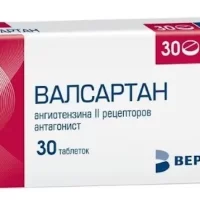Description
Metoprolol Pharmacodynamics
Cardioselective beta1-adrenoblocker. It has no membrane stabilizing effect and no intrinsic sympathomimetic activity. It has hypotensive, antianginal and antiarrhythmic effects.
By blocking in low doses beta1-adrenoreceptors of the heart, it reduces catecholamine-stimulated formation of cyclic adenosine monophosphate (cAMP) from adenosine triphosphoric acid (ATP), decreases intracellular calcium ion current, has negative chrono-, dromo-, batmo- and inotropic effects (decreases heart rate (HR), inhibits conduction and excitability, decreases myocardial contractility).
Total peripheral vascular resistance (TPR) at the beginning of beta-adrenoblocker use (first 24 hours after oral administration) increases (as a result of reciprocal increase of alpha-adrenoreceptors activity and elimination of beta2-adrenoreceptors stimulation), which returns to baseline in 1-3 days, and decreases with prolonged use.
The hypotensive effect is caused by a reflex reduction of minute blood volume and renin synthesis, inhibition of renin-angiotensin-aldosterone system (RAAS) activity (it is more important in patients with initial renin hypersecretion) and central nervous system (CNS), aortic arch baroreceptors sensitivity restoration (there is no increase of their activity in response to blood pressure (BP) decrease) and finally reduction of peripheral sympathetic effects. It reduces elevated BP at rest, during physical tension and stress. The hypotensive effect develops quickly (systolic BP decreases in 15 min, maximum in 2 h) and lasts for 6 h, the diastolic BP changes slower: a stable decrease is observed after several weeks of regular use.
Antianginal effect is determined by the reduction of myocardial oxygen demand as a result of HR shortening (prolongation of diastole and improvement of myocardial perfusion) and contractility, as well as myocardial sensitivity to sympathetic innervation. It reduces the number and severity of angina attacks and increases exercise tolerance. By increasing left ventricular end-diastolic pressure and increasing ventricular muscle fiber stretch may increase oxygen demand, especially in patients with chronic heart failure (CHF).
Antiarrhythmic effect is caused by elimination of arrhythmogenic factors (tachycardia, increased activity of sympathetic nervous system, increased content of CAMF, arterial hypertension), reduction of spontaneous excitation rate of sinus and ectopic pacemakers and slowing of atrioventricular (AV) conduction (mainly in antegrade and to a lesser extent in retrograde direction through AV node) and by additional pathways.
In supraventricular tachycardia, atrial fibrillation, sinus tachycardia in functional heart disease and thyrotoxicosis, it reduces heart rate or may even lead to restoration of the rhythm.
Prevents the development of migraine.
When administered in medium therapeutic doses, unlike non-selective beta-adrenoblockers, it has less pronounced effect on the organs containing beta2-adrenoreceptors (pancreas, skeletal muscles, smooth muscle of peripheral arteries, bronchi and uterus) and on carbohydrate metabolism.
When used in high doses (more than 100 mg/day), it has a blocking effect on both beta-adrenoreceptor subtypes.
Indications
– Arterial hypertension: lowering blood pressure and reducing the risk of cardiovascular and coronary death (including sudden death).
– Angina pectoris.
– In complex therapy after myocardial infarction (secondary prevention).
– Cardiac rhythm disorders, including supraventricular tachycardia.
– Functional disorders of cardiac activity, accompanied by tachycardia.
– Prevention of migraine attacks.
– Hyperthyroidism (complex therapy).
Contraindications
– Hypersensitivity to metoprolol or other components of the drug or other beta-adrenoblockers;
– Atrioventricular block of II and III degree (without artificial pacemaker);
– heart failure in decompensation stage;
– patients receiving prolonged or intermittent therapy with inotropic agents and agents acting on beta-adrenoreceptors;
– clinically significant sinus bradycardia;
– sinus node weakness syndrome;
– cardiogenic shock;
– severe peripheral circulatory disorders, including at risk of gangrene;
– Arterial hypotension (systolic BP less than 90 mm Hg);
– Patients with acute myocardial infarction with HR less than 45 bpm, PQ interval duration greater than 0.24 sec, or systolic BP less than 100 mmHg;
– patients receiving β-adrenoblockers are contraindicated for intravenous administration of slow calcium channel blockers (CMBs) such as verapamil and diltiazem (see section “Interaction with other medicinal products”);
– lactose intolerance, lactase deficiency and glucose-galactose malabsorption syndrome;
– under 18 years of age (efficacy and safety have not been established);
– severe bronchial asthma and chronic obstructive pulmonary disease (COPD);
– concomitant use of monoamine oxidase inhibitors (MAO) (see section “Interaction with other medicinal products”);
– pheochromocytoma (without concomitant use of alpha-adrenoblockers);
– period of breastfeeding.
Dosage and administration method
- Metoprolol should be taken orally, on an empty stomach, during or immediately after a meal.
- The tablets may be divided in half (but not chewed) and washed down with liquids.
- Arterial hypertension
100-200 mg of Metoprolol once in the morning or in two doses: in the morning and in the evening. If necessary, the dose may be increased or another hypotensive agent may be added. - Long-term hypotensive therapy with 100-200 mg of Metoprolol per day reduces overall mortality, including sudden death, and the incidence of brain stroke and coronary artery disease in patients with arterial hypertension.
- Angina
100-200 mg per day in two doses; morning and evening. If necessary, another antianginal drug may be added to therapy. - Cardiac rhythm disorders, including supraventricular tachycardia
100-200 mg per day in two doses (morning and evening). If necessary, another antiarrhythmic drug may be added to therapy. - In complex therapy after myocardial infarction.
- The maintenance dose is 200 mg per day in two doses (morning and evening).
- Administration of Metoprolol in a dose of 200 mg per day can reduce mortality in patients who have had myocardial infarction and reduce the risk of recurrent myocardial infarction (including in patients with diabetes).
- Functional disorders of cardiac activity accompanied with tachycardia
100 mg of Metoprolol once daily, it is recommended to take the tablet in the morning. If necessary, the dose may be increased. - Prevention of migraine attacks
100-200 mg per day in two doses; in the morning and in the evening. - Hyperthyroidism
150-200 mg per day in 3-4 doses. - Administration in special groups of patients
Administration in patients with renal insufficiency - No dose adjustment is required in patients with renal impairment.
- Administration in patients with hepatic impairment
Taking into account the low degree of binding of metoprolol to plasma proteins, no dosage adjustment is required. However, in patients with severe hepatic impairment (patients with severe cirrhosis or portocaval anastomosis), a dose reduction of Metoprolol may be required. - Use in elderly patients
In elderly patients it is recommended to start the treatment with 50 mg (1/ 2 tablets of 100 mg) per day (because the sharp fall in BP or the increasing bradycardia may be more pronounced). - What to do if you need to stop the drug
If it is necessary to interrupt or discontinue treatment with Metoprolol after long-term therapy, the dose should be gradually reduced by half over a period of at least two weeks. - If withdrawal symptoms occur, the dose should be reduced more slowly. Abrupt discontinuation of the drug may cause myocardial ischemia and may lead to exacerbation of angina pectoris or myocardial infarction, as well as exacerbate arterial hypertension.

